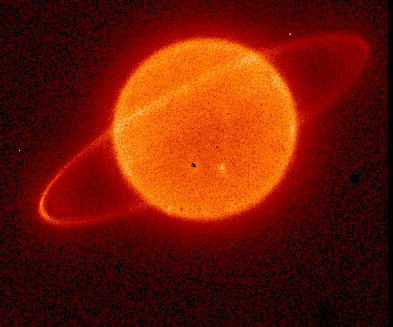Uranus is the seventh planet from the sun. It is also the coldest despite it being closer to the sun than Neptune. Like Saturn, Jupiter and Neptune, Uranus is one of the gas giants. In terms of size, it is the second least dense planet, after Saturn and the third largest planet in the solar system.

What Makes Uranus an Interesting Planet?
The way it spins sideways on its axis is perhaps the most interesting fact about Uranus. Its axis is tilted at more than 90 degrees making it look like a spinning barrel or a ball rolling on its side. Uranus takes 84 earth years to revolve around the sun. Due to this unusual tilt, each of its poles spends 42 years in daylight and then in darkness for the next 42 years.
Traditionally, scientists believed that a massive object may have crashed onto the planet and changed its axis. A more recent theory brought forward to explain this tilt is that a large moon was pulled away from Uranus by another planet. The powerful gravitational pull of this moon being pulled away caused the planet to spin on its side.

Where Did Uranus Get Its Name From?
Uranus is the only planet named after a god in the Greek mythology. Other planets are named after gods in the Roman mythology. Uranus is the Latin name of the Greek god of the sky. In some parts of Asia, this name translates to “Sky king star’’.
Uranus Is the First Planet Discovered In Modern Times
In 1781, William Herschel discovered Uranus as he was observing the sky on his telescope. It became the first planet discovered in the modern age after the invention of the telescope. At first, he thought it was a comet. However, it had been observed before as early as 1690 but mistaken for a star.

Uranus Has 27 Moons Named After Literary Characters
As of now, 27 satellites have been discovered on this planet. Some of them are large and others are small. The most popular of these include Oberon, Titania, Miranda, Ariel and Umbriel. These satellites are named after characters in Shakespeare and Pope’s works. Some of the moons were captured by Voyager 2 and others were discovered recently.

Uranus Is the Coldest Planet in the Solar System
Uranus is the coldest of all planets. The average temperature on its surface is -224°C. Unlike other planets, it emits less heat than it receives from the sun. Astronomers suspect this is because its core is extremely cold and cannot radiate heat.
Uranus Has the Second Most Dramatic Rings after Saturn
Uranus has two outer rings and nine inner rings. These are dark and narrow and the second most dramatic after Saturn’s bright rings. The first set of rings was discovered in 1977. The Hubble Space Telescope spotted the second set of rings in 2003. The rings are believed to be composed of black dust particles and large rocks and are suspected to have formed recently.

What Is Uranus Made Up Of?
Uranus is a gaseous planet whose space cannot be defined. The atmosphere is mainly Hydrogen, Helium and Methane. It is surface is made up of rock and ice merging into a large rocky core. For a long time, astronomers dismissed Uranus as a boring planet. However, observed under other wavelengths and with powerful telescopes, bands and cloud patterns are visible.
When observed in visible light, the atmosphere on Uranus appears to be a blue ball. This blue green haze is because methane on its atmosphere absorbs red light and scatters blue light producing a blue-green haze that makes it very difficult to see the interior of the planet.
Because of extremely high pressure, scientists speculate that there could be an ocean of diamonds on its surface. However, more research is required to determine whether this is the case.
Neptune is Visible with the Naked Eye
Despite it being so far away, it is possible to see Uranus with the unaided eye provided you know the planet’s current position and there are dark skies. You can also find the location of Uranus by using detailed charts. The best time to view this planet is just before dawn, in the evening or after sunset. Observed with a simple telescope, it appears as a small disk.
There Has Only Been One Visit to Uranus
There has only been one visit to Uranus made by the spacecraft Voyager 2 in 1986. It flew by past at a distance of 81,500 km from the planet’s surface. It captured pictures of the planet and its moons. No other mission has been made and there are no plans under way to visit it soon.
